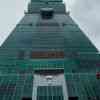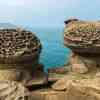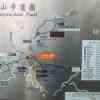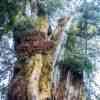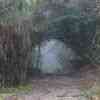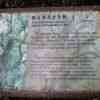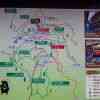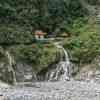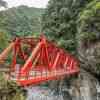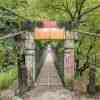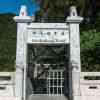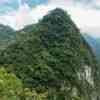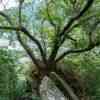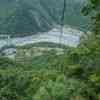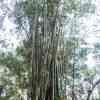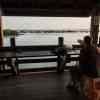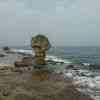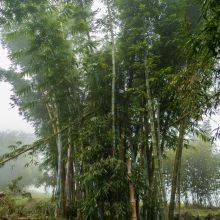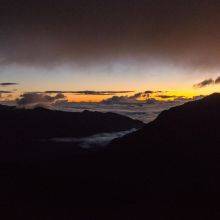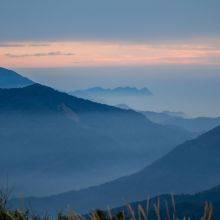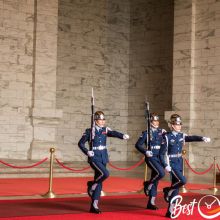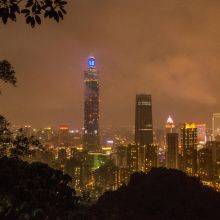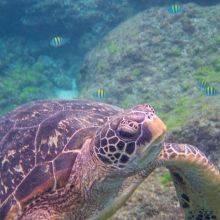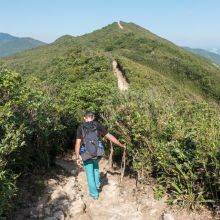When Is the Best Time
Exceptional, beautiful, and fascinating: Taiwan! The mountainous island is utterly safe for travelling and a great place to meet some of the friendliest people on our planet. Read my season tips and a complete guide with tips for every spectacular place in Taiwan!
When is the best time? You can travel to Taiwan throughout the year but consider typhoons are likely to happen from July to October. The driest months are from November to April. These are the best months to travel around the entire island. During summer (July and August), Taiwan is overrun by the Taiwanese.
Weather Overview
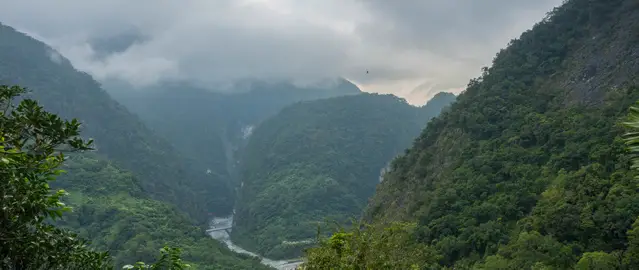
Taroko Gorge
If travelling to Taiwan, you have to consider that it frequently rains throughout the year. There is much more precipitation on the east side due to the high mountain range. Most rainfall occurs from May to October. In these months, Taiwan gets hit by typhoons regularly, especially in the east and in the central mountain range.

Breakwater on the East Coast
The northern part of Taiwan and the Taipei area is colder than the south, like in Kaohsiung and Kenting. Being there for quite a while, we learned that the weather forecast gives you an indication. Still, often it's better than predicted, especially in the drier season from November to April. Find more weather details here: Monthly Weather Taipei - Taiwan North — Monthly Weather Tainan - Taiwan South
Spectacular Sunrise and Sunset
Taiwan is famous for its spectacular sunsets and sunrises. I give you insider tips for the popular spots and show you the hidden gems as well. Just mesmerizing! We visited the fantastic island already a couple of times, and we still can't get enough of the attentive people and adventurous hikes.
Alishan National Forest Recreation Area

View from Alishan
Alishan is famous but also an extremely crowded spot to view the sunrise. If you depend on public transport, it's one of the view sunrise spots where you can get to. However, it's utterly crowded, which makes it hard to enjoy the sunrise. You can't watch the sunrise in Alishan only on the 2.489 m high Zushan mountain. Take the sunrise train which runs just once from the Alishan station early morning. If the train is not fully booked, you can get tickets from 1 pm to 4.30 pm the day before. The departure of the train depends on the time of the sunrise. Each afternoon at 4.30 pm, the exact time will be mentioned. Ask at your hotel reception for the departure time. When booking the hotel, ask them to make a reservation for the sunrise train for you the next morning. It's a short ride up almost to the summit of Zushan. To catch the train, you have to get up very early between 4, and 5 am. It's a bit of a hassle during the sunrise, but you can take an amazing pictures.

The rest of the day shuttle buses are offered but only every 2 hours. 9/11/13/15. The Zushan area is also beautiful in the daytime, and the views are awesome. Take the sunrise train or the bus later in the day to the top and walk back through the forest to Alishan. Consider frequently the clouds already rolling in before midday. Therefore, you may be covered in clouds from midday onward.
Tip: Stay in Alishan if you want to watch the sunrise; otherwise, you have to get up in the middle of the night. The hotels here are fully booked very far in advance, although most of them are not outstanding. The best one perfectly located in Alishan is the Alishan Hotel ****.
An excellent budget option is the Legendary Bed and Breakfast in Fenqihu. The owners; Mr and Mrs You walk an extra mile for you. We prefer Fenqihu, which is much quieter and located close to the Dadongshan Trail.
More information and details about Alishan and Fenqihu can be found in our detailed description of the Central Mountain Range.
More Beautiful Sunrise and Sunset Places Without Crowds
Besides Alishan, there are even more outstanding locations in Taiwan to experience a gorgeous sunrise above the horizon or a mesmerizing sunset in the evening. Let us show you the best ones:
- Linzhi Mountain

Linzhi Mountain is not far from Alishan already in the Yushan National Park is still one of the hidden gems. You can either come here for the sunrise or just early morning to watch the spectacular Alishan Mountain Range and the highest peak with 3.952 m Yushan or Jade Mountain. The Linzhi Mountain Loop Trail is roughly 7 km long and takes 3 1/2 hours. It's an easy and well-marked 1/2 day hike. Due to the high elevation, you may watch the sea of clouds before midday—parking at Takaka Visitor Center. The visitor center is closed every second Tuesday each month. Bring water and a sandwich. There is just a restaurant but no shop. Takaka Visitor Center Google Maps
- Dadongshan or Dadong Mountain
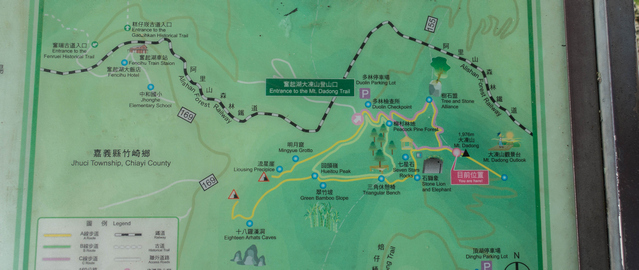
Spectacular hike and views without any crowds can be experienced from Dadongshan or Dadong Mountain. It's already part of the Alishan National Scenic Area and close to Fenqihu. Here you can watch a stellar sunrise with fewer people on the 1.976 m high Dadongshan or Dadong summit. It’s an hour drive west of Alishan. The climb is roughly 2 km up one way, and it may take up to an hour. The trail can be slippery and muddy. Watch the roots and stairs along the path. During summer, be aware of thunderstorms in the afternoon. Mosquitos occur here at this time of the year. Winter can be pretty chilly. When you reach the viewing platform, you can see the highest mountain of Taiwan Mount Yushan on a clear day; during winter covered in snow. Mount Yushan also called Jade Mountain is 3.952 m high above sea level. Also here frequently clouds roll in at midday and spoil the breathtaking view. hen we hiked the trail we ended up in fog. However, you walk through lush vegetation full of life, and we enjoyed the mystic atmosphere. You can either hike the short circular trail or add another one. Have a look at the hiking map of Dadongshan. Dadongshan Trailhead and Parking Google Maps
- Hehuanshan

Hehuanshan near Taroko Gorge with a height of 3000 m is an excellent spot for the sunrise. You can already watch the sunrise from your hotel room, or you climb to one of the summits of Hehuan Mountain. For detailed information, read our article about Hehuanshan at Sunrise.
- Eryanping Trail

Popular by locals, not so much by foreign visitors, is the Eryanping Trail through tea plantations between Longmei and Shizhuo. The area has the perfect climate to grow tea due to dense fog and cool temperatures in the afternoon like at Alishan. The Oolong - high mountain tea grows mainly at an altitude of 900-1200 m. It's a short steep trail up mostly on steps leading to two outlooks. Parking is available at the trailhead, and there are restrooms as well. Nice farm stalls and six fresh waffles for a less than 1,50 € are offered. Eryanping Trail Google Maps
- Guanwu

We also watched a beautiful sunset at Guanwu where you can get to by car. It's 5 minutes walk to the viewing platform only. Guanwu is also excellent for hiking and famous for two thousand years old giant Formosan Cypresses. Detailed information in our Guanwu National Forest article.
Cherry Blossom and Sakura Season

This is the most famous time of the year in Taiwan. Depending on the elevation level it usually takes place between the end of February until mid-April. The most popular places are Yangmingshan and the Wuji Tianyuan Temple, Wulai Waterfall, Sun Moon Lake and, Alishan. All these places get utterly crowded, especially during the weekend.
Season Details
Before we dive into our adventure experiences and ideas for your next visit, let us give you a detailed season overview. What to expect in terms of climate, highlights, and crowds:
Spring (March-May)
In terms of weather March and April are often sunny while heavy rainfall starts in May. March has pleasant temps above 20°C but not too hot. Temps are Increasing in April and May, as it's already hot with high humidity. However, rain showers can always occur. March and April are perfect months if you'd like to see Taiwan in full bloom. In April and May, we highly recommend visiting Guanwu for the rhododendrons.
Summer (June-August)
Temps are above 30°C, and it's not a pleasant time. During the Computex in June, the biggest IT show in Asia, it's heavily crowded in Taipei. July and August is the peak season because the residents go on vacation. Much Taiwanese travel either to the cooler mountains or to the sea. Often to Kenting in the south to escape the heat. Expect high humidity and lots of precipitation. These are the wettest months on the entire island and typhoons can occur.
Autumn (September-November)
There is still lots of rain until the end of October, and typhoons are likely to occur until the end of September. October gets drier but not on the east side. November is one of the driest months with pleasant temperatures above 20°C, but it's often cloudy in the north. We can't recommend travelling in September, due to the rainfall. October and November are much better and not very crowded except in Taipei.
Winter (December-February)
The temps in winter are still pleasant at day time, roughly around 20°C and sometimes slightly below. The temperatures in the mountains are pretty chilly during the night from December to March. In January and February, the peaks are often covered with snow. Snow is something special for the Taiwanese, and many travel to higher elevations like Hehuanshan or Alishan.
Avoiding Crowds
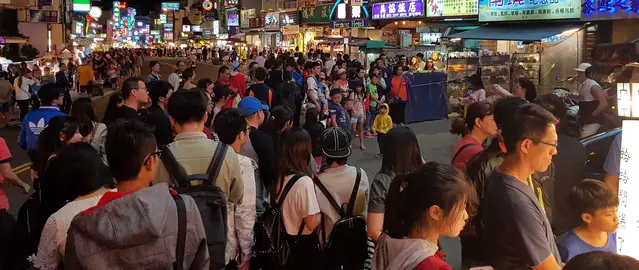
Tourists from non-Asian countries still overlook so many regions of Taiwan. Of course, the famous attractions in Taipei, like the World Trade Center or the Chiang Kai-shek Memorial Hall, as well as Taroko Gorge, Alishan, and Kenting, are popular and crowded. In general, Taipei is extremely busy during the summer between July and August and from the end of December until early January. Weekends are always super busy. The Taiwanese have very few holidays. That's the reason for the very crowded weekends almost everywhere on the entire island. It tends to get busy from Friday midday onwards. Even worse is Xitou, which is busy even on weekdays due to retired hiking people. However, the hinterland and not well-known places by tourists are just visited by residents. What did we do to dodge the crowds? We went on adventures and deep into nature. Particularly on weekends to get away from the masses. That's how we shared beautiful nature with very few people only. Tip for the famous spots: If you'd like to visit the popular places, get there early in the morning to dodge the most crowds.
These are my recommended tours via GetYourGuide with 24 hours advance cancellation policy. Thx for booking via my website! With your support, I am able to provide all information first-hand. Tour prices are at no extra cost!
Best Months to Visit
Location and Tips

The mountainous island of Taiwan is a great destination to meet some of the friendliest people on our planet and utterly safe to travel independently. The variety of food and different tastes are exceptional. Nature is mind-blowing, and there are outstanding hiking pearls often not well known. You won't believe it, but central Taiwan has 286 mountains more than 3000 meters high and the highest density of mountains in the world. The coral reefs are so colourful, and you even may be surrounded by green turtles while snorkelling. Mobile network connectivity is almost everywhere, even at the remotest campground.
I am very much fascinated by this island and its people. The reason it became my biggest guide of all. I inserted a "Table of Content" to give you an overview about my entire guide:
Taipei
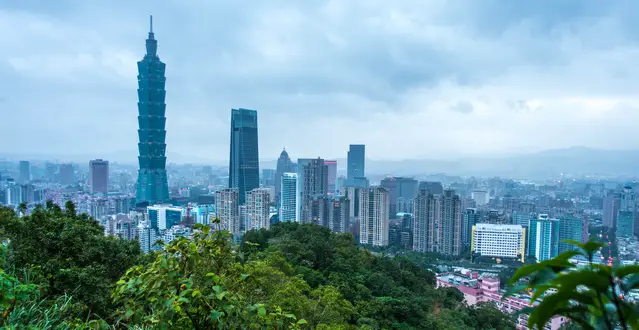
Taipei is a vibrant city with an estimated population of almost 3 million people. For two very famous spots, visit our helpful articles:
Yangmingshan
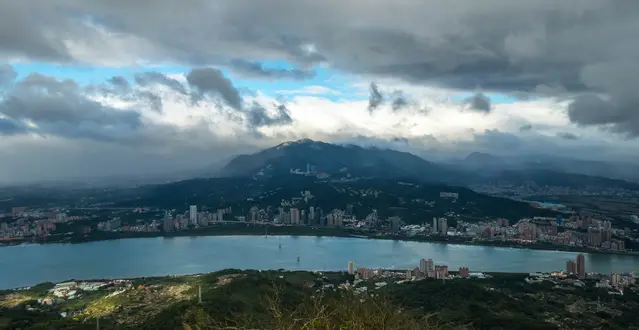
Yangmingshan National Park view from Guanyinshan
Location: North of Taipei, situated on a geological fault. Perfect for a day trip from Taipei. Famous for volcanoes, hot springs and, first of all, hiking. The most popular trail is the climb up to Mount Qixing. At 1.120 m, it's the highest peak in the Yangmingshan National Park. Shuttle buses inside the National Park are provided, weekdays roughly every half an hour and weekends more often every 10 to 20 minutes.
How to get to Yangmingshan: Take the red line to R15 Jiantan (There is an information centre as well) and just outside catch bus 5.
Crowds at Yangmingshan: As everywhere in Taipei, weekends and bank holiday are the busiest days. Spring is the most popular time of the year due to the cherry blossom season, and it gets crowded everywhere. Summer is also a popular time, but Yangmingshan is often covered in clouds, and it's raining at the extinct volcano. January to March/April are the best months, followed by November and December for a Taipei visit regarding crowds and weather. However, it may be sunny in Taipei while Yangmingshan is hidden in clouds.
Parking at Yangmingshan: There is traffic control during weekends and holidays. Getting to one of the available parking lots is recommended on weekdays only. Erziping Visitor Center Link for Google Maps, one of seven inside the park.
Guanyinshan National Scenic Area - Special Tip
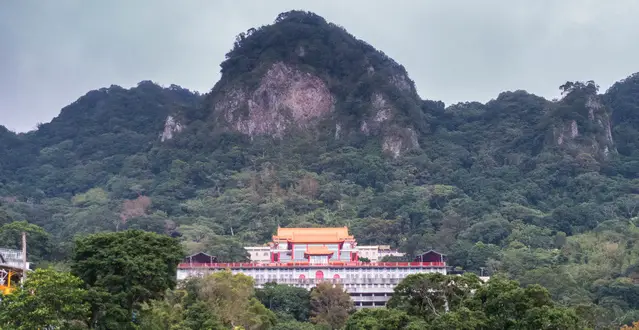
Climbing to the top of Mount Qixing is spectacular on a clear day. Although it is sunny in Taipei, the Yangmingshan National Park may be covered in clouds. An alternative is the Guanyinshan National Scenic Area on the opposite of the Tamsui River in the Bali District. The trailhead starts at the visitor centre to the top of Yinghan Peak. The view from the summit of the 609 m high Yinghan to Yangmingshan and Taipei City is stunning. Watch the skyline in the evening and walk the easy trail back. Bring a torch for the descent.

Depending on your fitness level, you need half an hour up to an hour for the ascent, mostly just a steep climb on steps. If you are into hiking, there are a couple of trails at Guanyinshan. Ample parking is available around the visitor centre where you find facilities as well. Close to the top of Yinghan are also restrooms.
Crowds at Guanyinshan: During the weekend, many residents climb up here doing their exercises but very few tourists only. During the week, the walk is less frequented. We climbed up twice and had nice chats with Taipei residents.
How to get to Guanyinshan: Easy to reach by car even during the weekend. By public transport, take the orange line until Luzhou Station (last station) and take the O20 Taipei City Real-Time Bus to Lyngyun Temple. Visitor Center Google Maps
Dalongdong Baoan Temple and Confucius Temple
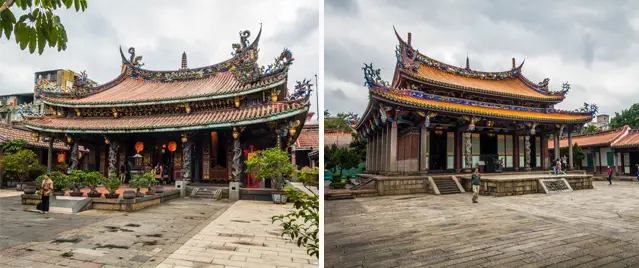
Left: Dalongdong Baoan Temple. Right: Confucius Temple
Both are close to MRT (red line) Yuanshan. The Baoan Temple is the most impressive shrine in Taipei. It's the only Taiwanese temple with the Unesco Cultural Heritage Preservation Award. Open from 6.30 am to 10.30 pm daily - entrance free. Take some time at the Confucius Temple to learn more about the Confucian Six Arts. Open Tuesday to Saturday from 8.30 am to 9 pm and Sundays until 5 pm – entrance free.
Maokong Gondola
One of the most popular attractions in Taipei. You get here via MRT red line until Daan, then change into brown line BR last exit Taipei Zoo. The gondola was built in 2007 and is four amazing km long. The views are spectacular to the jungle and Taipei City. There are 30 cabins or so, all equipped with a glass bottom. When you arrive at Maokong, you first have to line up for a ticket where your gondola time is mentioned. There are two lines to queue, one for the ordinary cabins and one for the glass bottom cabins. Come early on weekdays at 9 am and weekends at 8.30 am to avoid queuing for hours. They don't operate on Mondays.
The Best Hotels in Taipei
We highly recommend a hotel close to the MRT red line in Taipei. We'd chosen the Papersun in Shilin at our second visit close to the red line, the Shilin Night Market, and the Huarong Day Market. For us perfectly and quietly located where breakfast was included. They prepare an excellent coffee for you with self-roasted coffee beans in the afternoon. These rooms are newly renovated former dormitory rooms.
Other great hotel options along the red line:
- Dandy Hotel-Daan Park Branch; The hotel is located opposite of a forest park in walking distance to the red line and restaurants. Airport shuttle is available, which was very helpful for us on our first visit. Breakfast is included, and the staff is just wonderful.
- Folio Daan Taipei; The hotel also has an excellent location with restaurants nearby. The rooms are spacious and comfortable, some even with a balcony. An airport shuttle is available. The Daan metro station is right around the corner.
More Places to Visit (Around Taipei)
There are awesome places around Taipei, often easy to reach by public transport or rental car. To experience the lush vegetation of Taiwan, you don't need to travel far. Taipei is an impressive city, but the surroundings give you an idea of the nature Taiwan has to offer.
Teapot Mountain
The trailhead is just a 10 km drive from Elephant Trunk Rock. Location Teapot Mountain Google Maps trailhead at the Jinguashi Gold Ecological Museum.
Trail duration; roughly four hours at a slow pace, included are stops for taking pics. Exposed hike, not well marked and maintained, pretty hot on a sunny day and slippery if it's raining. The trail can be slippery and muddy. The northeast of Taiwan experiences the most precipitation. More details about the hike.
Shenao Elephant Trunk Rock

Parking at the Shenao Fishing Harbour. The harbour is quite popular for seafood, and it's crowded at lunchtime as well as at low tide. Elephant Trunk is more well known by Taiwanese people and gets busy from Friday midday onwards. The rock formations are similar to Yehliu Geopark but not that overrun. Access to the peninsula around low tide only. It's an outstanding alternative if you like to avoid the masses of tourists at Yehliu. Location Elephant Trunk Google Maps

"Little or small Yehliu" before the Elephant Trunk Rock
Special Tip: Make a stop at the famous Nanya Rock along with the north-east coast road #2. Pretty busy and popular for wedding pictures. Location Nanya Rock Google Maps

Wulai Waterfall and Hot Springs

Wulai is located 25 km south of Taipei. It’s a popular hot spring area. It takes 20 minutes for the 1.6 km walk from Wuxi town to the picturesque 80 m high Wulai Waterfall. A little railway, in former times used to transport timber, leads to the falls as well.
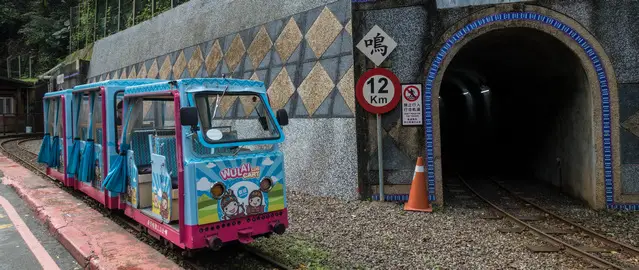
During weekends Wulai is packed with locals. Wulai is famous for the hot spring spas, but you can also experience these natural hot springs in the river without an entrance fee.

You get to Wulai easily by car; ample parking is available. With public transport from Taipei, take the green line to Xindian and from here bus 849. It may take an hour to get to Wulai. Location Wulai Parking Google Maps
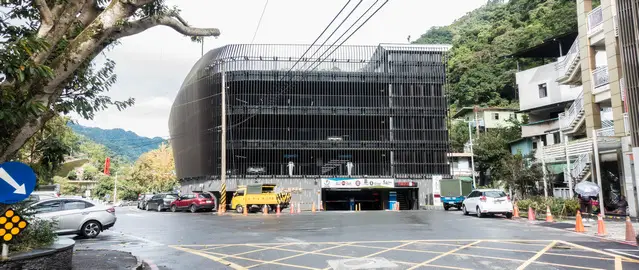
Day and Night Food Markets

One of the most culinary highlights in Taiwan are the daily food markets often night markets with budget prices around the island. Very popular is the Keelung night market northeast of Taipei. This market is open 24 hours and offers one of the widest varieties of food.
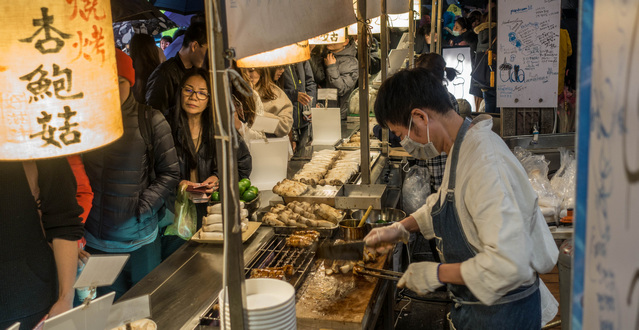
We loved the Shilin Night Market and the Huarong Market, a local day market one km north of the night market. Shilin Night Market and Huarong Day Market Google Maps Nevertheless, there are many more night markets around Taipei with plenty of choices for Asian food freshly prepared.

Our tip for Shilin: Stay in the Papersun Hotel, located in the middle of the night and day market in walking distance to the red MRT line.

Taiwanese love to eat eggs!
Transport in Taipei

The Taipei Metro MRT operates from 6 until 24. It's very convenient to use, especially during rain. The Metro Main Station is mega huge with shops and a huge variety of food. Our favourite store is a sushi shop — one package for 100 Nt; less than 3 Euro.

There are five different lines available, and you can get almost everywhere. The red line in the centre was the one we used most. You get with Tamsui-Xinyi Line to Yuanshan, Chiang Kai-shek, the TWTC, and Elephant Mountain Hill. The different lines frequently depart every view minutes at least every ten minutes at day time. Taipei Metro passes for 24h/48h/ 72h are available. Metro Map and Timetable

The most common transportation is the scooter like in other Asian countries. In some cities, it's an issue when driving a rental car. The scooters overtake cars on both sides. You always have to check twice before you turn right or left.
Hiking in General in Taiwan

That's me on a muddy trail after rainfall
Taiwan has plenty of not well-marked hiking trails in the pure wilderness one of the reason why we love Taiwan. Locals often use these tracks. Therefore, it’s helpful having a mobile hiking app like “Locus Pro”. Although everything was in Chinese, we always figured out the correct trail back to our car. The popular walks are well marked even in English. There are always hikes closed for years due to extensive typhoon damage.

A permit is requested for longer and famous hikes especially trails situated 3.000 m above sea level. For some hikes, like in the Taroko Gorge, you need to apply for a permit minimum of three days before at the Taroko National Headquarter and the police as well. In other parks, it's one or two days before you plan to hike. The police want to inspect your hiking gear before handing over a permit. If you hike with a Taiwanese resident, it’s easier to get the permit. We experienced that the mentioned duration for hiking trails in National Parks and Forest Recreation Areas was often too high. Usually, you need half of the time or even less.
Central Taiwan - Mountainous Area

Taroko Gorge

Changchun Shrine
You get to Taroko: either by bus from Taipei, or train to Hualian or Hualien south of Taroko or by train to Xincheng closest city to Taroko. From the train station, take a bus to the Taroko Gorge National Park. Stay close to Taroko at least two, better three nights if you like to explore some of the many hikes inside the park. Either rent a car in Taipei or a scooter after your arrival to explore Taroko independent.
4 Hikes in the Taroko Gorge

Unfortunately, for most of the thrilling hikes, you need a permit which is pretty tricky to get. The following three short and famous tracks can be hiked independently but arrive either early or late in the afternoon when the crowds thin out. Hike number four is not known, therefore quiet. This hike was a tip of our host of the Stick-On B&B close to Taroko. He even gave us more ideas, but unfortunately, we only spent two nights here. There are guided hikes offered but pretty expensive.
- Swallow Grotto; The 1 km return stroll along the Liwu River takes roughly half an hour. It is utterly overrun, a small parking area only!

- Shakadang 8 km return hike, but most people already turn back after the first km. Limited parking; try to arrive early or late in the afternoon; otherwise, park your car 1 km eastwards.

If you hike the entire trail, you can enjoy the beautiful landscape almost alone. The trail is flat and easy to walk.
- A beautiful, not much crowded 30 to 45 minutes return hike starts at the Changuang Temple,

leading above a suspension bridge and to Bell Tower. Usually, you can continue until the famous Changchun Shrine, but the track was closed due to significant damage. The trail is steep, always climbing up offers spectacular views.
- We recommend hiking an unmarked track next to the visitor centre. The pro you don’t stick in traffic jams, and not many hikers are along the beaten track. First, follow the signs to the Dekalun Track. The first part of the walk is unspectacular and wide at the beginning. There are shortcuts along with a water pipeline which was more fun to hike. The picture is shown where you have to leave the trail.

Leave the Dekalun Track and follow this narrow, steep path.
When you leave the well-maintained trail, the adventure begins on a not marked loop hike. Always steep up with hands and feet above roots, rocks, and slippery soil until you get to a platform with a spectacular view to Taroko. Continue hiking until you get to a crossing where you can climb further up to the village Dali or along the loop trail back to the visitor centre. It was already late afternoon, the reason we went back.
The first part is not steep until we approached a long staircase with more than 1000 steps down, always zigzagging, which was the best option to get back. View people only hike the strenuous staircase up and down, which is called Dali Trail. This trail leads to an awesome forest, and birds accompany you.
Camping in the Taroko Gorge
Camping in Taroko is an awesome experience, though be prepared for rain in the late afternoon or evening. Mosquitos occur, so take precautions. There are two campgrounds close together; the Lushui and Heliu. Usually not busy located close to the main highway which leads through Taroko. Google Maps location for Heliu Campground

The campground is well equipped with water, toilets, cold showers, and electricity. It's a small camping area with 12 sites all on a platform protected from flooding rain.
Tip: Don’t miss the beautiful Qingshui Cliff along the coastal Hwy 9 already part of the Taroko National Park.

It’s a 2.5 h to 3 hours drive through the Taroko Gorge direction Lishan in the mountains to get to the famous Mount Hehuanshan/Hehuan.
Mount Hehuan or Hehuanshan
Watching the sunrise from Mount Hehuan is an exceptional experience. It's easy to get here by car but not by public transport. The best months for a sunrise tour to the top of Hehuanshan are during the driest time of the year from December until March. The sunlight has a little variation from summer to winter rising in June shortly after 5 and in January around 6.40. The mountain area is also excellent for hiking. Like to figure out more? Read my detailed article about Hehuanshan sunrise; how to avoid the crowds, where to stay, and many more.
Sun Moon Lake

The biggest freshwater lake is located in the heart of Taiwan almost 750 m above sea level. The lake is also home to the smallest aboriginal tribe of Taiwan; the Thao. It’s a roughly 3 hours drive from Taipei and one of the most visited places throughout the year. Weekends are super busy, and accommodation prices are at the highest level. The only exception is during wintertime in December and January when the crowds are bearable on weekdays. We visited the lake in December on a weekday, and except for some tour buses it was quiet here.

Tip: Around midday, most visitors are having lunch; the best time to enjoy one of the famous sights.
My 2 Favorite Sights at Sun Moon Lake
- Ci'en Pagoda was built by Chiang Kai-shek in 1971.

The Pagoda situated on a 954 m high hill and can be seen from the Wenwu Temple already. This beautiful monument is 46 m high, so the top is exactly 1000 m high. It was built in memory of Chiang Kai-shek's mother. It’s a short walk of 700 m but always steep uphill on steps. Important to know if you like to climb to the top: Opening hours from 9 am to 4.30 pm. The view from the top is just spectacular, especially in the morning and late afternoon. It’s a narrow road up to the small parking lot not suitable for buses, therefore, less busy.
- Wenwu or Wen Wu Temple for the sunset.

It’s an impressive temple and plenty of steps to climb up to the rooftop to watch the sunset. The temple was built in honour of Confucius and Guan Yu. There are 366 steps up to different levels. There is ample parking along the road to the temple.
Festivities Around Sun Moon Lake
- September; Swimming is usually not allowed except for the Sun Moon Lake Swimming Carnival. It’s a race of about 3 km at the beginning of fall in September. A maximum of 25 thousand people from over the world take part annually. In 2018 the event took place for the 35th time.
- During October and November, fireworks are held.
- February is unique for the Cherry Blossom Season.
Transport at Sun Moon Lake

Biking around the lake on the 33 km road is pretty popular. Plenty of public transport by ferry and bus around the lake is offered. The biggest villages are Ita Taho and Shuishe. Boat trips can be booked here, and a visitor centre is available, many restaurants and street food are offered. However, Shuishe is the hub for Sun Moon Lake. Day trips from the Lake to Xitou are offered, but we recommend staying at least a night at Xitou for hiking deep into the forest. Sun Moon Lake Map and transportation overview

How to get to Sun Moon Lake? Public transport map to Sun Moon Lake
Xitou Bamboo Forest and Recreation Area
Xitou is one of the most popular parks in Taiwan and an exceptional park for walking. Most of the paths are paved, but if you are into hiking, you can find an excellent steep trail up to the top with spectacular views of the mountain range. To experience the beautiful landscape of the park with fewer people, you have to hike far. It's pretty busy here with thousands of retired Taiwanese who like to do their exercises. Regarding the weather in Xitou, it's recommended to arrive early morning before the clouds roll in around midday. Curious about the not well-known loop trail in Xitou? Check out my detailed article about the Xitou Loop Trail and get the most out of your stay.
Alishan National Forest Recreation Area
Alishan is the most popular area to watch the sunrise. Avoiding crowds is almost impossible. Even in the shoulder season during winter, it's busy here. There are a couple of well-marked trails in Alishan leading to ancient trees and a temple.

The Three Generations Tree
Want to visit by car? There is limited parking with only 120 spots.

The only available car park inside the Alishan National Scenic Area
However, shoulder parking outside the Recreational Area is available, and shuttle buses pick you up frequently during the cherry blossom season. Expect many thousand visitors each day at the sakura season at the end of the winter and beginning of spring.
How to get to Alishan
It takes 2. 5 hours from Chiayi TRA Station to Alishan by bus. Another option is the train from Chiayi to Fenqihu. It's a popular village where the railway stops at 1.400 m elevation. The Alishan Forest Railway used for logging by the Japanese siege in the past is now a popular tourist attraction. Many visitors take the train from Chiayi to get to Alishan. Unfortunately, the railway got hit by a typhoon in 2009 and now operates until Fenqihu only. From here you have to take the bus to continue travelling to Alishan. Alishan Railway Station Google Maps
The nearby Fenqihu / Fencihu Village
One of the popular villages is Fenqihu, where the railway stops close to the Dadongshan Trail on 1.400 m elevation. The village is much quieter; accommodations are cheaper, like the Legendary B&B. The owners, Mr and Mrs You, walk an extra mile for you. Fenqihu is a peaceful village with lovely residents. We'd chosen one of the view campgrounds twenty minutes before the village. The campgrounds are always well maintained with spotless facilities. We paid 700 NT$, roughly 20 euros for a campsite for two.
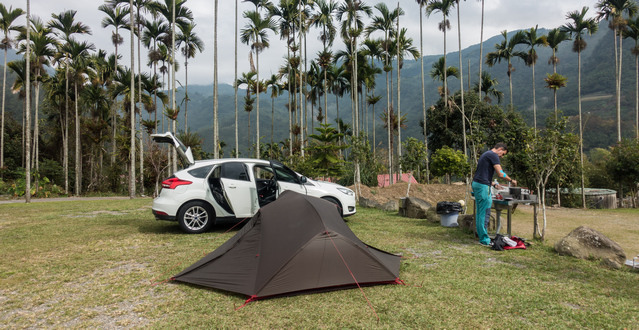
East Taiwan - South of Taroko Gorge
East Rift Valley National Scenic Area

Rice Field
It’s famous for rice paddies, hot springs, and river rafting. River rafting on Xiuguluan River depends on the water level; therefore only possible during the rainy season from the end of April until October. The tour starts in Ruisui but can be booked from Hualien as well. It’s a 1.5 h drive from Hualien south to Ruisui (Google Maps Location)
Sanxiantai Arch Bridge

Footbridge with eight arches leading to an island. Usually packed with tourists, weekends and summer are even worse. There are a huge parking area, a shop, and facilities. It’s a nice photo stop, but in our opinion, not worth a detour. (Google Maps Location)
South-West Taiwan
Taijiang National Park

The endangered black-faced spoonbill can be spotted from September to March, only accessible by rental car or scooter from Tainan City. We spotted the spoonbills but in the far distance only. The outlook is very well made. Binoculars are provided. One of the National Park employees monitors the birds and let you have a closer look at the computer.
Kaohsiung City
It's the second biggest city in Taiwan, with an estimated 2 million people. It’s now home to the “National Kaohsiung Centre for Arts” Opened to the public on October 13 in 2018. It's the biggest of its kind in the world. However, here you may experience the worst pollution on the entire island.
South West and South East Islands - Visit at Least One
- Xiao Liuqiu

The Island is easy to reach by ferry and situated close to the mainland. Many daytrippers visit the island, but it's worth staying here. Accommodations and campgrounds are available. More details about Liuqiu and snorkelling with turtles can be found in our article. You get to the island from Donggang harbour. Don't miss the exceptional seafood market. Choose the seafood you like and let it prepare for you. This dinner was the best seafood dinner in our life!
- Lanyu or Orchid Island more remote located

It is said to be the most beautiful island in Taiwan, but it experiences abundant rainfall. In the middle of the volcanic island is a 552 m high hill. The coral reef in the north is one of the most colourful reefs in Asia. It’s an excellent diving and snorkel spot. You can get around easily by scooter. Even during summer, the island is not crowded. A few accommodations are available. Unfortunately, low-level nuclear waste is stowed here in the south. Ferry and flight services are more likely to be offered during summer.
- Ludao (Green Island)
Green Island is popular to be one of the best diving and snorkel spots in Taiwan. You get here either by plane, a 15 minutes flight or by ferry, which takes almost an hour. Crowds: During weekends and summer holidays, thousands of people come here each day and reservations are essential. The island can be explored easily by scooter. If you come during winter, you may have the island for yourself. Rain occurs frequently. Flights and ferries are cancelled last minute if there is inclement weather predicted.
South Taiwan

Kenting is popular for its beaches and attracts millions of visitors each year. Spring and especially summer are the busiest and, needless to say, the weekends. Anyhow, you may find a stretch of sand for yourselves. Snorkelling is a must-do with all the colourful corals, and you definitely escape the crowds. We haven’t seen many people snorkelling at the entire peninsula. Most people rent a scooter in Kenting for transportation.

The night market on the main road in Kenting is worth a visit. Interesting is the Chuhuo Special Scenic Area – natural gas fires which are most impressive in darkness (evening, night)
Camping in Taiwan
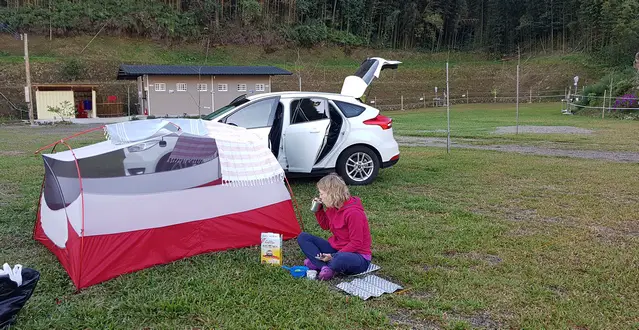
That's me close to Guanwu enjoying my coffee
Camping is very popular, and campgrounds are well maintained. We experienced spotless facilities with few campers during the week, but weekends, summer, and the New Years holidays until the 2nd of January are overrun. The campsites are pretty small, and one tent is pitched to the next in the peak season. When we travel through Taiwan, we just book the first days in Taipei in advance. Let the weather decide where you are heading next. It wasn't any effort to find a campground and excellent site on the day of arrival, but we avoided weekends. Just hotels and guesthouses we booked two days before. This works well as long as you are travelling in the winter from November to April; except for Chinese New Year and the short New Years holidays.
Holidays in Taiwan
The residents are working hard and much. They don’t have many days off. That’s the reason that the weekends and the summer are super busy. In 2019 a weekend was included in the New Years holidays and five days off were an exceptional state. Everybody was travelling to the mountains or the sea. However, the service along the highways is very efficient. Although it was super crowded, no one had to queue for a restroom; more than 50 for each gender. Everything is very well organized on this island.
Transport in Taiwan and Rental Cars

The public transport in Taiwan and Taipei is excellent. All major cities and almost every town are connected by the TRA (Taiwan Railway Administration). The public transport by bus also works very well as long as you are travelling between bigger cities and towns. The remote hinterland (backcountry) is not well connected. The reason that we rented a car. Some of our favourite places are pretty remote and accessible either by rental car or guided bus trip. Renting a car is not common, but much easier than you might think. All traffic signs are in Mandarin and English as well. You have Wi-Fi on the entire island, even in the most secluded areas. Therefore, it’s pretty easy to navigate with Google around the island. The highway fees are affordable, roughly 20 Euros for two weeks if you travel around the whole Taiwan island. The handling with the rental car companies is always effortless. We'd always chosen Avis. The gas prices are almost everywhere the same and pretty cheap with less than 0,80 € for one litre. In big cities the traffic on highways is managed on two levels; the upper one with view exits and the ground level with more exits. Big traffic jams are rare.
Mobile 4G Internet Almost Everywhere

Mobile network connectivity is almost everywhere available even at the remotest campground, including the islands and very affordable. Get it directly at the Taoyuan International Airport (TPE) Terminal 1 and Terminal 2 arrival hall before customs.
- Card Format: Nano, Micro or Standard sizes
- Validity period: 3, 5, 7, 10, 15, or 30 days once activated with unlimited data!
- Price roughly between $ 10 and $ 35.
7 Eleven
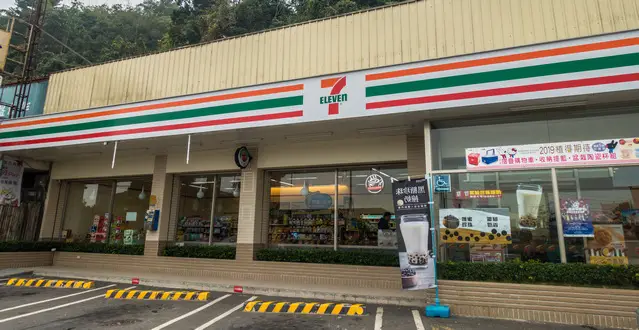
Everything you need for your daily life is available at 7 Eleven Stores around the Island. From dairy products and cereals to small hot meals, cold and hot beverages, stationery, toilet tissues, umbrellas, mosquito repellent, and even an ATM can be found here.










